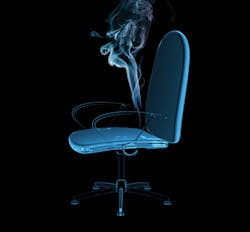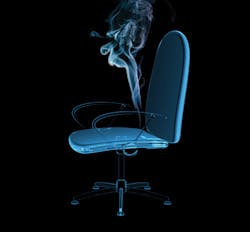Is sitting really the new smoking? (And what does that have to do with dentistry?)
Desirée Walker, DDS
Several years ago, despite my best efforts to lead a healthy, active lifestyle, I learned that I was really in a health category no better than the one I'd be in if I were a smoker! What?! I was outraged, insulted, and confused. Like many of you, I thought I went to great lengths to guard myself from the destruction and mayhem a habit like smoking causes to the body. I was really having a hard time believing this. Why? The research-supported article stated that my habitual sitting throughout the day was the equivalent of smoking. What's more alarming is that the dangers of chronic sitting are not negated even if you exercise regularly.
You may have come across the sensationalist health phrase, "Sitting is the new smoking," coined by James Levine, MD, director of the Mayo Clinic at Arizona State University. Over the past decade, numerous studies have correlated chronic sitting with an increased risk of many chronic medical conditions. Chronic sitting has been shown to increase the risk of type 2 diabetes, cardiovascular disease, breast cancer, kidney disease, colon cancer, and the big one . . . death.1 Many medical and health professionals have started referring to long periods of inactivity and its negative consequences as "sitting disease."
So what does sitting disease have to do with dentistry? If you are a dental professional who sits most of the day, you are not immune from the dangers of sitting. Your health is affected, your work is affected, and your career longevity might be as well.
As I discussed in my previous article, "Go paleo: Dental caveman ergonomics," our ancestral genes were selected based on how well we could handle vigorous physical activity. Moreover, our bodies thrived on how well we moved. Our genes have not evolved much since that time, but our environment has evolved drastically. We now survive and thrive in our dental professions by efficiently navigating our chair-driven, tech-filled, sedentary environments. Although our environments are a convenience of modern times, our bodies and health can eventually show signs of chronic sitting, which can ultimately lead to career disruption.
As dental professionals, we all like to imagine long and fruitful careers. We cannot achieve our fullest potential in our professions and lives if our health is compromised. We must acknowledge sitting disease as a problem in our work and commit ourselves to avoiding the plague. Many individuals rely on us for their health care, so we must care for ourselves in order to provide care for others. We can't allow sitting disease to wreak havoc on our bodies.
Is it possible to find the perfect position in dentistry to avoid sitting disease? I have the answer! OK, here it is . . . drum roll please . . . the perfect position does not exist!
So what are we to do? Are we doomed? I recall feeling quite deflated when I learned about the dangers of sitting disease. This was my normal sitting routine: Sit down for breakfast, sit down to read the news and social media, sit down to commute, sit down to prep my work schedule, sit down for morning patient care, sit down for lunch, sit down for e-mails and social media, sit down for afternoon patient care, sit down for patient notes, sit down to commute, sit down to eat and unwind, and then call it a day. Can you relate to this routine with eight-plus hours of sitting down? Sitting disease, here I come.
So what are we to do? Here are three simple guidelines I use and find effective for combatting sitting disease:
1. Reduce optional sitting time.
2. Prioritize position and mechanics whenever possible.
3. Perform 10 to 15 minutes of daily maintenance on your body.
Reducing optional sitting time
Below are my top two recommendations for reducing your optional sitting time throughout the day.
Be aware of your optional sitting time.
This requires actually writing down your sitting routine, like I did above, and problem solving about how you can incorporate movement or standing. I discovered that most of my optional seated time occurred while I was eating and at my computer. As I discussed in "Go paleo," I installed a stand-up desk station in my private office.
What if you don't have the luxury or freedom of installing a commercial one? Just use a stand-up desk riser, or you can even go cheap with a cardboard-box riser for your computer. Throw a couple of boxes on top of the desk, place your monitor on the boxes, and work standing up. On the weekends, I do much of my administrative practice work and other deskbound projects on a cardboard box that sits on top of a small, cheap folding table. The simplicity is beautiful, it's easy to incorporate, and it makes it easy for me to move more while working.
Automate "stand up and move" reminders.
It can be as simple as setting your phone alarm to vibrate every 30 minutes (if you're with patients and can't have the noise interruption) or using a popular wearable fitness tracker, such as one made by Fitbit, Garmin, Jawbone, or Apple. Personally, I use the Fitbit One during my workday because it clips under clothing, eliminating OSHA and infection control concerns. It also has a vibration alarm that will go off if I don't walk 250 steps per hour. It is hidden and minimalist, and it gets the job done by reminding me to get up and move. I'm also a big fan of timer.com. When I'm at any of my stand-up desks or laptops, I love setting this. Its loud, obnoxious buzz is great for those longer solo projects. I'm currently using it as I write this article.
Prioritize position and mechanics
Prioritize your position and mechanics whenever possible. Although ergonomics is not the complete solution to sitting disease, we must educate ourselves on proper positioning and make our environments ergonomically friendly. I encourage you to read some great resources about positioning and mechanics. Try Practice Dentistry Pain-Free: Evidence-based Strategies to Prevent Pain and Extend Your Career by Bethany Valachi, PT, MS. This is a comprehensive, research-based manual for positioning in dentistry. Ms. Valachi is the leader in our field when it comes to dental ergonomics, and the valuable information she provides in this book is a true health treasure.
You should also consider a positioning evaluation. Pelton & Crane does these for free. You can catch Pelton & Crane at a dental trade show or request for someone to visit your office. Their ergonomic evaluator will make sure your body is in the right position while you do dentistry. They also have an app for your iPad where you can send in a positioning photo for critique.
Your operatory chair is also important. The Pelton & Crane narrow-back patient chair, the Spirit 3300 series, embodies my philosophy of being able to move freely while performing dentistry. The patient chair has a narrow back, which allows you to move around the head of your patient (at the 12-o'clock position). In other words, you can move around the patient without compromising your body by placing it in awkward positions. Sitting disease can do enough bodily damage. Be sure not to exacerbate the problem by having a poor chair that promotes bad ergonomics.
Your operator stool is another important piece of equipment to analyze. To promote good body mechanics, it needs an adjustable pelvic tilt. This position allows the upper thighs to have a downward tilt when seated. This tilt promotes better alignment of the spine, helps reduce stress and strain on pressure points, and promotes blood flow to the backs of the legs and the lower back. I'm a fan of the saddle stool variation, and brands that I like are BodyGuard Pro Saddle by Orascoptic, the Straddle Stool by RGP Dental, and the ErgoSolex by BQE. I encourage you to try a brand that works well for you. Each seat is different and everyone has a slightly different preference.
Daily body maintenance
Your body deserves 10-15 minutes of daily maintenance. The self-maintenance I'm referring to includes mobility techniques used to resolve pain, improve joint and tissue range of motion, and restore suppleness to tight muscles. Like brushing your teeth and flossing, self-maintenance will be more effective if you commit to a daily practice. Don't wait for back and neck pain to signal that you are sitting too much or that you have poor office ergonomics. Here are some of the mobility moves and tools I use daily.
1. Walking is probably the most important "mobility" movement we can do. Feet, legs, hips, core, and arms (in the swing of your gait) all get moved around, and blood flows to these parts to keep them healthy. You need, of course, more than 10-15 minutes per day, but use this as an adjunct to your normal fitness routine.
2. Foam rolling is useful for massaging tight muscles. Basically, you roll them out like you would a dough ball with a rolling pin. Foam rolling promotes blood flow, aids in recovery of muscles, and loosens the painful knots that can form after a long day in the clinic with patients.
3. Sitters' stretch is my go-to stretch for when I do have to sit for longer periods of time. This stretch targets your piriformis muscle, a muscle deep in your hip that connects your sacrum to the top of the thigh bone. When this muscle is stiff from too much sitting, your hip and leg motions can irritate the sciatic nerve. To do the stretch, sit on the edge of your chair, keep the left foot on the floor, and cross the right leg over so the ankle is resting on the left knee. Sit up straight, then slowly lean forward until you feel a nice deep stretch. Hold for 15-30 seconds and repeat with the other side.
The overarching goal is to be more active throughout the day. Our bodies need movement like they need food and water, and movement is the key to curing sitting disease. I don't believe that "sitting is the new smoking," but I do believe that being sedentary is. Give your body the movement it craves, and your career, health, and body will be nourished. Reference
1. Biswas A, Oh PI, Faulkner GE, et al. Sedentary time and its association with risk for disease incidence, mortality, and hospitalization in adults: A systematic review and meta-analysis. Ann Intern Med. 2015;162(2):123-132.
Desirée Walker, DDS, is a general dentist and owner of Lumber River Dental in Lumberton, North Carolina. She graduated from the University of North Carolina at Chapel Hill School of Dentistry in 2008. Outside of her practice and training for her next appearance on American Ninja Warrior, she does yoga and gymnastics outdoors with her two cats, Lu and Jones. She can be contacted at [email protected].
Editor's note: To read Dr. Walker's article, "Go paleo: Dental caveman ergonomics," from our October issue, search "caveman ergonomics" on DentalEconomics.com.
Editor's note: To download the Pelton & Crane ergonomics app, search for "Narrow Back Advantage" in iTunes.

